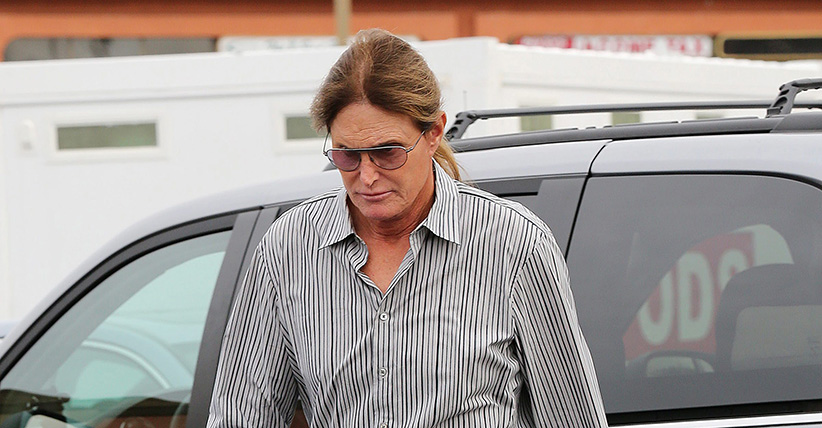The risky state of becoming trans in public
Society has become more accepting on trans rights. But for people about to transition? That’s another story.
Bruce Jenner. The Kardashians out and about, Los Angeles, America – 01 Dec 2014
Share

Listen to Emma Teitel read her column, or subscribe to Maclean’s Voices on iTunes or Stitcher for on-the-go listening:
There was a moment early on in last month’s Comedy Central roast of loathed Canadian pop star Justin Bieber when Kevin Hart, the comedian hosting the show, made a predictably inane joke about Bruce Jenner—the retired Olympian and reality-TV star whose newly feminine appearance has triggered speculation about his gender identity. “There were rumours that Justin [was] dealing with Kendall Jenner, and that shocked me,” Hart said, referring to the possible budding romance between Bieber and Kendall Jenner, Bruce Jenner’s 19-year-old fashion-model daughter. “You gonna deal with a Jenner,” Hart continued, motioning to Bieber, “I thought it would be Bruce.”
The joke had a resoundingly awkward effect on the room, where Kendall Jenner and her older sister, Kourtney Kardashian (Bruce’s stepdaughter) happened to be sitting. People laughed loudly and uncomfortably; others gasped, a visceral acknowledgment of Hart’s political incorrectness and the close proximity of Bruce Jenner’s progeny, who smiled unconvincingly, the way people do when pained in public by a cruel joke. Many criticized Hart’s Jenner jibe as, beyond utterly stupid, outright transphobic. (In fact, it was one of three Bruce Jenner jokes of the night; the other two, made by Jeff Ross and Will Farrell, were cut from the program.) The joke’s core cruelty, however, stemmed not from its subject matter but from its timing.
Jenner, whose changing appearance we have seen mainly through the crude lens of media outlets such as US Weekly and TMZ, is expected to come out as trans on April 24 in a hugely anticipated sit-down interview with Diane Sawyer. It’s no mystery that life for many trans people is uniquely harrowing. According to the National Transgender Discrimination Survey Report, an American study of more than 6,000 respondents, 57 per cent of trans people have experienced “significant family rejection,” and “a staggering 41 per cent of respondents reported attempting suicide.” Numbers from the Trans PULSE Project, a study from Ontario, paint an even bleaker portrait. Suicidality—the likelihood that a person will take his or her own life—among study respondents “varied greatly by medical-transition status, with those who were planning to transition sex, but who had not yet begun, being most vulnerable,” the study said.
And what do you know? It is precisely at this time—before transition—when trans public figures are subject to heightened ridicule. Bruce Jenner, if we are to assume for a moment that he is trans, is embarking on the most vulnerable part of his journey in the unforgiving light of the public sphere, where people don’t take kindly to things they don’t understand. (In January, In Touch Weekly photoshopped a picture of Jenner wearing women’s clothes and lipstick. The headline read, “My life as a woman.”) Mainstream media have recently received trans actress Laverne Cox with open arms; Janet Mock, a transgender writer and activist, is a New York Times bestselling author. Both women’s popularity and respect within media is a wonderful thing. Yet it is worth noting that the public has seen them only as the women they are today—and not the people they were before they transitioned.
“I think the media are most respectful of people who first come to the public eye after they’ve come to terms with themselves,” says Parker Molloy, a trans writer and activist. “In my own life, I’ve found that a lot of the people who knew me before I started hormones and all that have struggled more with accepting who I am.”
Molloy points to something else that may make Jenner’s potential transition greater cause for ridicule: his athletic legacy. “He was a monument to masculinity,” says Molloy, referring to Jenner’s Olympic career in the 1970s. “I have to imagine that, for people old enough to remember Jenner’s ’70s-era celebrity, maybe this challenged their view of masculinity.”
Some people may bristle at the idea that a guy who was once front-and-centre on a Wheaties box might identify as a woman. Compounded with this image is Bruce’s status as the patriarch of a reality-TV family (the Kardashians) who command about as much respect in the American psyche as the chicken pox. It’s possible, then, that media are using Jenner’s sleazy TV persona as an excuse to pursue humiliating coverage. The problem is that this coverage has an impact beyond Jenner and his family.
“I’m more concerned about the message this sends to some 12-year-old kid who’s really trying to come to terms with [him- or herself],” says Molloy. “Seeing the media treat the speculation over whether or not someone is trans is deeply harmful, when you feel alone in the world.”
Bruce Jenner may be many things, but he is not alone in the world. If he announces his transition at the end of the month, it is very likely the media will give him favourable coverage; that Perez Hilton and TMZ will congratulate him on his courageous decision. I predict there may even be a lull in cheap jokes about the former athlete, a kind of comedy armistice to respect the seriousness and bravery of his announcement. This will likely be deemed a sign of progress in the advancement of trans rights. And yet, the reality will remain: We were at our meanest when Jenner’s public persona was at its murkiest. When he wasn’t the brave and resolute spokesperson, we were mocking and nasty. We were unkind at precisely the moment our kindness mattered most. To me, that’s not called progress.